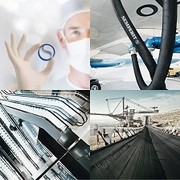
Austrian public listed firm Semperit Group says it will focus on its transformation as an industrial rubber specialist and sell off its medical business Sempermed. The rubber products company said this will allow it to focus on the production of conveyor belts, construction materials and hoses.
The rubber products company says in the light of the “very dynamic competitive environment”, maintaining the medical business would require high investments since its competitors invest up to 20% of their annual revenue in capacity expansion and automation. Due to this also there was an impairment loss of EUR46.8 million as of 30 September 2019, the firm said.
“We have made the biggest strategic landmark decision of the past decades very deliberately: It shall ensure the future viability and higher profitability of the Semperit Group. The future of Semperit is clearly in the industrial sector,” said Dr Martin Füllenbach, CEO of Semperit
He continued, “Despite our clear improvement of the operating performance indicators at Sempermed from the second quarter of 2019 on, we are faced with drastically intensified competitive dynamics in the medical sector; the capacity-based gap between us and the market leaders is growing. This is why we are firmly convinced that our medical business can be better continued and developed by different owners.”
Semperit sees higher earnings and profitability potential on the basis of a stronger focus on the industrial sector, which it says is characterised by a significantly higher profitability, a more successful performance and the option for technological differentiation in regional and application-based niches.
“There is a clear prioritisation of selling the medical business as a whole, which we will evaluate thoroughly and in detail,” says Füllenbach. “In accordance with the very established culture in Semperit’s almost 200-year long corporate history, we will start talks with employee representatives in a timely manner in this context. The goal in the coming months must be to create the best possible conditions to give Sempermed employees a perspective for the future.” Possible restructuring costs will then be derived from the specific transaction structure and are therefore not yet quantifiable.
The sale of Semperit’s medical segment, which includes latex gloves, could be done in whole or in part. It also would affect the Sempermed production sites as well as Semperit’s facility in Wimpassing, Austria, which produces surgical gloves in addition to serving the Semperform and Semperflex segments.
“Our main site in Wimpassing will unquestionably remain a part of the Semperit Group,” says Füllenbach, who wants to give the domestic production site a higher relevance. “Against the backdrop of a slowdown of the global economy, we are currently working on a site concept.”
Based on its strong know-how in materials and processes, the Semperit Group will also concentrate more strongly on its application knowledge in future. The chemical and process-oriented fundamental knowledge that has been available for many decades is to be used more substantially for the development of new products going forward. A clear focus of the new industrial strategy is on innovation and digitalisation.
“Rubber as our material has to face the requirements of Industry 4.0 and deliver digital functionalities as well,” says Füllenbach.
Until the end of 2024 – the 200th year in the company history – Semperit is to grow again to a significantly higher revenue volume through organic growth steps and a clear M&A strategy.
In connection with the focus on the industrial sector, Semperit re-defines the target set at the beginning of the restructuring process (until now: EBITDA margin of approximately 10% from the end of 2020) and strives towards an EBITDA margin of approximately 13% until the end of 2024.
